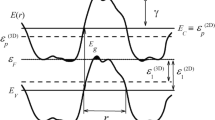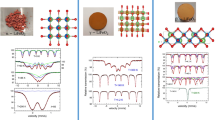Abstract
Selective chemical etching and transmission electron microscopy are used to study the defect formation in Ge1−x Six/Ge(111) epitaxial heterostructures at 0.01<x<0.35. As the Si content in the solid solution (SS) increases, the dislocation densities in the epitaxial layer, at the interface, and in the near-interface region in the substrate are found to vary nonmonotonically. The difference in the depth distribution of dislocations observed in the heterostructures in three different SS composition ranges is caused by the effect of the SS composition on the kinetics of misfit-stress relaxation, in particular, on the intensity of misfit-dislocation generation and multiplication. It is found that, in the heterostructures grown by hydride epitaxy at 600°C, misfit-dislocation multiplication through a modified Frank-Read mechanism occurs only in the range 0.03<x<0.20. The results obtained are explained in the context of the effect of silicon-rich microprecipitates, which form during the spinodal decomposition of the SS, on dislocation generation and motion in the epitaxial layer. A mechanism is proposed for misfit-dislocation generation by heterogeneous sources in the epitaxial layer; the mechanism is based on the generation of interstitial dislocation loops near microprecipitates.
Similar content being viewed by others
References
T. Hackbarth, H.-J. Herzog, M. Zeuner, G. Höck, E. A. Fitzgerald, M. Bulsara, C. Rosenblad, and H. von Känel, Thin Solid Films 369, 148 (2000).
M. Bauer, K. Lyutovich, M. Oehme, E. Kasper, H.-J. Herzog, and F. Ernst, Thin Solid Films 369, 152 (2000).
C. S. Peng, Z. Y. Zhao, H. Chen, J. H. Li, Y. K. Li, L. W. Guo, D. Y. Dai, Q. Huang, J. M. Zhou, Y. H. Zhang, T. T. Sheng, and C. H. Tung, Appl. Phys. Lett. 72, 3160 (1998).
F. K. LeGoues, MRS Bull., April 38 (1996).
Yu. B. Bolkhovityanov, O. P. Pchelyakov, and S. I. Chikichev, Usp. Fiz. Nauk 171, 689 (2001) [Phys. Usp. 44, 655 (2001)].
D. D. Perovic and D. C. Houghton, Inst. Phys. Conf. Ser. 146, 117 (1995).
D. C. Houghton, J. Appl. Phys. 70, 2136 (1991).
R. Hull and J. C. Bean, Appl. Phys. Lett. 54, 925 (1989).
R. Hull, J. C. Bean, L. J. Peticolas, B. E. Weir, K. Prabhakaran, and T. Ogino, Appl. Phys. Lett. 65, 327 (1994).
R. Hull, E. A. Stach, R. Tromb, F. Ross, and M. Reuter, Phys. Status Solidi A 171, 133 (1999).
V. I. Vdovin, M. G. Milvidskii, T. G. Yugova, K. L. Lyutovich, and S. M. Saidov, J. Cryst. Growth 141, 109 (1994).
T. G. Yugova, V. I. Vdovin, M. G. Milvidskii, L. K. Orlov, V. A. Tolomasov, A. V. Potapov, and N. V. Abrosimov, Thin Solid Films 336, 112 (1998).
V. I. Vdovin, Phys. Status Solidi A 171, 239 (1999).
A. Lefebvre, C. Herbeaux, C. Bouillet, and J. Di Persio, Philos. Mag. Lett. 63, 23 (1991).
F. K. LeGoues, B. S. Meyerson, J. F. Morar, and P. D. Kirchner, J. Appl. Phys. 71, 4230 (1992).
K. W. Schwarz, J. Appl. Phys. 85, 120 (1999).
V. I. Vdovin, O. A. Kuznetsov, M. G. Mil’vidskii, L. K. Orlov, and T. G. Yugova, Kristallografiya 38(4), 269 (1993) [Crystallogr. Rep. 38, 573 (1993)].
X. W. Liu, A. A. Hopgood, B. F. Usher, H. Wang, and N. S. Braithwaite, J. Appl. Phys. 88, 5975 (2000).
A. R. Powell, S. S. Iyer, and F. K. LeGoues, Appl. Phys. Lett. 64, 1856 (1994).
A. Rockett and C. J. Kiely, Phys. Rev. B 44, 1154 (1991).
J. W. Matthews, J. Vac. Sci. Technol. 12, 126 (1975).
J. P. Hirth and J. Lothe, Theory of Dislocations (McGraw-Hill, New York, 1967; Atomizdat, Moscow, 1972).
W. Hagen and H. Strunk, Appl. Phys. 47, 85 (1978).
V. I. Vdovin, L. A. Matveeva, G. N. Semenova, M. Ya. Skorohod, Yu. A. Tkhorik, and L. S. Khazan, Phys. Status Solidi A 92, 379 (1985).
R. Beanland, J. Appl. Phys. 72, 4031 (1992).
M. G. Mil’vidskii, N. S. Rytova, and E. V. Solov’eva, in Problems in Crystallography (Nauka, Moscow, 1987) [in Russian].
M. Yu. Gutkin, I. A. Odiv’ko, and A. G. Sheinerman, J. Phys.: Condens. Matter 15, 3539 (2003).
M. V. Mezhennyi, M. G. Mil’vidskii, and T. G. Yugova, J. Phys.: Condens. Matter 14, 12997 (2002).
E. P. Kvam, Philos. Mag. Lett. 62, 167 (1990).
Author information
Authors and Affiliations
Additional information
__________
Translated from Fizika Tverdogo Tela, Vol. 46, No. 8, 2004, pp. 1476–1483.
Original Russian Text Copyright © 2004 by Yugova, Mil’vidski\(\overset{\lower0.5em\hbox{$\smash{\scriptscriptstyle\smile}$}}{l}\), Vdovin.
Rights and permissions
About this article
Cite this article
Yugova, T.G., Mil’vidskii, M.G. & Vdovin, V.I. Defect formation in Ge1−x Six/Ge(111) epitaxial heterostructures. Phys. Solid State 46, 1520–1527 (2004). https://doi.org/10.1134/1.1788788
Received:
Issue Date:
DOI: https://doi.org/10.1134/1.1788788




